For decades, IBM Corp.’s IBM Z has powered some of the world’s most sensitive, high-volume transactions. But, with the recent launch of the IBM z17, the narrative is shifting.
IBM Z’s role is no longer just about maintaining uptime and supporting critical systems. It’s evolving into a catalyst for new business models, expanded workloads and deeper enterprise integration, according to theCUBE Research’s John Furrier (pictured, left).
“Z is not just surviving, it’s thriving,” he said. “Clients are modernizing around Z. A couple notes here — [a] 2x increase in use cases, which shows that Z is starting to venture into what I would call mainstream transaction processing beyond their core base.”
During the “IBM Z: Hybrid Cloud With Advanced AI Where It Matters Most” event, IBM Z executives sat down with theCUBE Research’s Dave Vellante and Furrier to share what’s next for the IBM z17 platform. (* Disclosure below.)
A new product vision shaped by client priorities and AI ambition
Tina Tarquinio (pictured, right), vice president of product management and design, IBM Z and LinuxONE, at IBM, brings a mix of ambition and accountability to her perspective on Z’s evolution. She sees not just a technological leap, but a reaffirmation of IBM’s platform-first approach, where AI is embedded from silicon to software and customer input has become a central force shaping product strategy.

IBM’s Tina Tarquinio talks with theCUBE about how IBM z17 represents a new product vision based on client priorities.
“We’ve spent over 2,000 hours with our clients doing user research to come up with what are we going to put in the next-generation mainframe,” she said. “[Were’] really focusing on what they need, when they need it and how they need it.”
That focus is most visible in the artificial intelligence architecture of the IBM z17. Telum II processors provide a 7.5x throughput increase for AI workloads while using less energy. With the watsonx platform integrated throughout the software stack, IBM aims to support multimodal, real-time inferencing for mission-critical applications across industries, according to Tarquinio.
“This is a full platform launch — AI technology on the chip, attached Spyre accelerator, and AI all the way up through the full software stack,” she said. “That’s part of our secret sauce: teams that work on the silicon all the way through the application layer.”
One of the biggest drivers behind the IBM z17 design is reducing the latency of AI-powered scoring. By embedding accelerators on-chip, IBM enables real-time fraud detection and anti-money laundering scoring without off-platform data transfers. This helps clients meet strict service-level agreement requirements without compromising on performance, security or cost, according to Tarquinio.
“If you’re swiping your credit card, you want that to happen quickly,” she said. “We’ve designed Spyre so that it can run that second model and still meet all the SLAs. We’re talking milliseconds of time here.”
The IBM z17 platform also reflects IBM’s work to simplify the mainframe experience for a new generation of users. Building on established DevOps practices and reducing the complexity of system admin roles, the goal is to abstract away tuning and optimize for skills already available in the workforce, Tarquinio added.
“We leverage IBM Design Thinking,” she said. “We work through what should be the priorities and what do we want to introduce with z17. We’ve done a lot of work, too, on the application developer persona … and now we’re shifting our focus to the system administrators.”
Inside IBM z17: New chips, old myths and the rise of transactional AI
While some industry observers still see the mainframe as a legacy technology, IBM Z continues to defy that notion. The z16 program became IBM’s best-ever performing mainframe release, with 120% revenue growth over three years, according to Ross Mauri, general manager, IBM Z, at IBM. That momentum reflects not just the durability of mainframe systems, but their rising importance in an era defined by hybrid cloud complexity and pandemic-accelerated digital transformation.

IBM’s Ross Mauri talks with theCUBE about mainframes’ rising importance in an era defined by hybrid cloud complexity and digital transformation.
“From a revenue point of view, z16’s been an outstanding success, thanks to our clients,” Mauri said. “But I think it’s because of the relevance of the mainframe in their environment today, which I say is different than it was maybe seven [or] eight years ago.”
With IBM z17, the company expands on that success through hardware upgrades engineered for enterprise-grade AI. The updated architecture features enhanced acceleration units, allowing each core to access up to eight AI engines simultaneously. Meanwhile, the Spyre accelerator introduces encoder and decoder model support, with transactional AI inference and assistant-style agents running natively on Z. These updates increase throughput while reducing dependency on external frameworks or rewrites, according to Mauri.
“We’re really upping the amount of horsepower from a predictive AI point of view that clients can put against their AI,” he said. “The real benefit is the software capabilities and the productivity that our clients are going to see.”
That productivity hinges on speed and, increasingly, on the ability to embed inferencing directly into transactional workflows. In sectors such as banking, where tens of thousands of transactions occur every second, every millisecond matters. With z17, IBM aims to minimize latency by integrating AI accelerators directly into the processor, eliminating the delays of external compute paths, according to Mauri.
“The game is latency and latency reduction,” he said. “We’ve been able to make it so that a client can do a full inference — and now multiple inferences — all less than a millisecond within that whole transaction.”
IBM’s resurgence in platform performance isn’t happening in isolation. Analysts point to closer alignment across IBM Research, product development and go-to-market execution as a driving force behind the mainframe’s momentum, according to Vellante.
“IBM’s future depends on its innovation agenda,” he said. “What has happened is [that] IBM Research has really aligned much better with product … and go-to-market.”
The convergence of hardware and software innovation is a tidal wave reshaping the mainframe’s role across enterprise environments, Mauri explained. That includes advancements in database systems, observability tooling and threat detection, further reinforcing Z as a fully integrated, end-to-end platform.
“Our clients … need to connect the mainframe with their whole enterprise,” Mauri said. “That’s what [IBM’s] Skyla Loomis and her team are delivering, and that’s why I’m so excited.”
From core to connected: IBM Z software strategy bridges hybrid cloud and AI ops
Skyla Loomis, general manager, IBM Z software, at IBM Corp., views her mission through a clear lens: Remove friction, reduce complexity and invite a new generation of developers and operators into the Z ecosystem. Her team leads everything above the operating system — from core runtimes and data management to compilers, security tooling and AI ops — with the goal of simplifying how enterprises interact with the mainframe.

IBM’s Skyla Loomis talks with theCUBE about how the Z operating system is designed to simplify how enterprises interact with the mainframe.
“We want to seamlessly integrate into the hybrid cloud,” Loomis said. “We want to empower and embed AI around all of that to really dramatically simplify and reduce the skills that are needed to be successful.”
IBM is phasing out platform-specific scripting in favor of enterprise-standard tools such as Ansible and Terraform. The idea is to empower users without requiring deep Z operating system knowledge while AI steps in to automate tasks and surface trusted actions through natural language interfaces, Loomis explained.
“You’re now more starting to move into infrastructure as code,” she said. “And with the advent of AI, it’ll help with generating some of that automation … so you’re really able to be much more productive, much more efficient.”
To reduce the risk of change in legacy apps, IBM pairs standard dev tools with AI-powered visibility. By integrating Git, Jenkins and Visual Studio Code directly into Z OS, developers can work in familiar environments while using AI to understand dependencies, data flow, and code behavior, according to Loomis.
“I often think of these applications as big tangled-up balls of string, and you’re afraid to pull on one of the strings because you don’t know what it’s connected to,” she said. “This is where I think AI becomes a game changer for us because we’re able to give you X-ray vision into that ball of string.”
Z software also helps businesses unlock insights from proprietary data that remains on-platform for compliance and security reasons. With AI models now running natively on Z, organizations can execute real-time analysis on claims and transactions without offloading data, Loomis added.
“All of your insurance claims flow through it if you’re an insurance company … you’re almost not an enterprise without those things,” Loomis said. “We can automate a lot of that process leveraging the AI that we have built into the platform.”
IBM is also modernizing IT operations through AI-driven observability and anomaly detection. With telemetry data flowing across systems, domain-specific agents can now correlate and act on problems faster than human operators ever could, according to Loomis.
“With agentic AI … they can talk to each other,” she said. “We want to get to also providing the explanation of everything that happened. So, there’s transparency … we’re not just helping them catch their fish. We’re teaching them how to fish.”
Here’s the complete video interview, part of SiliconANGLE’s and theCUBE’s coverage of the “IBM Z: Hybrid Cloud With Advanced AI Where It Matters Most” event:
Find out more there on why IBM z17 is the AI-infused next-generation mainframe.
(* Disclosure: TheCUBE is a paid media partner for the “IBM Z: Hybrid Cloud With Advanced AI Where It Matters Most” event. Neither IBM Corp., the sponsor of theCUBE’s event coverage, nor other sponsors have editorial control over content on theCUBE or SiliconANGLE.)
Photo: SiliconANGLE
Your vote of support is important to us and it helps us keep the content FREE.
One click below supports our mission to provide free, deep, and relevant content.
Join our community on YouTube
Join the community that includes more than 15,000 #CubeAlumni experts, including Amazon.com CEO Andy Jassy, Dell Technologies founder and CEO Michael Dell, Intel CEO Pat Gelsinger, and many more luminaries and experts.
THANK YOU

